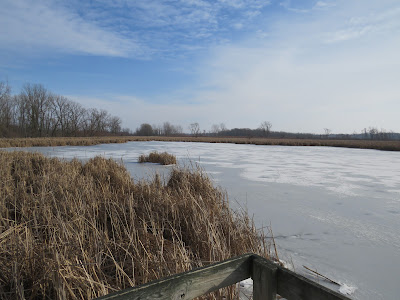On a partly sunny and frigid morning, Caroline and I make our way along a snow-covered path in Mt. Pleasant’s Chipp-A-Waters Park. Soon, I pause on the bank of the Chippewa River to watch it round the bend and head northeast into the city limits. According to today’s measurements from the Mt. Pleasant station: water depth is 3.6 ft. and the flow rate is 290 cubic ft./sec. Further ahead, I notice a Winterberry shrub with some remaining fruit as well as a Multiflora Rosebush with some hips still attached. Rose hips are edible and very rich in vitamin C as well as vitamin B and carotene. Since they are usually acidic and rather astringent, they’re rarely eaten fresh, but rather cooked with sugar. It’s important, however, to remove the seeds before consuming hips. Their seeds are covered in irritating hairs that can cause unpleasant reactions to the skin and mucous membranes. Often this irritation is carried right through the digestive tract. As a result, the French call rose hips “gratte-culs” (butt scratchers), while American Indian tribes described the result as “itchy bottom disease.” As the morning sun breaks through the clouds, my attention is drawn to the river channel where beams bounce off the rippling, flowing water. Following the path into a wooded area, I pause to face the base of a massive Eastern Cottonwood tree. According to the posted sign, this massive tree has a diameter of 71 inches and a circumference of 220 inches-meaning it would take 3 lengthy adults, holding hands, to encircle the tree. Nearby, I spot fresh tracks of a Cottontail rabbit and a Musclewood (Blue Beech) tree still holding on to its dead leaves. Further ahead, I notice a large “graveyard” of mature Ash trees. Before the Emerald Ash Borer began killing them in large numbers, Ash trees were one of the most valuable and abundant North American woodland trees: estimates of total numbers ranged between seven and nine billion. Since 2002, this insect has destroyed 40 million ash trees in Michigan alone and hundreds of millions throughout other states and Canada. Next, we cross a footbridge over the river and follow a circular path around Veit’s Woods where I notice several immature Beech trees still had their leaves attached. Finally, we retrace our steps back to the car and head for home.
Early morning sunbeams
create long shadows
over the icy river flow,
illuminate the far bank
with glistening white,
warm the gray Juncos
in the leafless dogwood,
reveal tracks of a mink
hunting near shore,
light up my spirit with
nature's wonderland
D. DeGraaf



